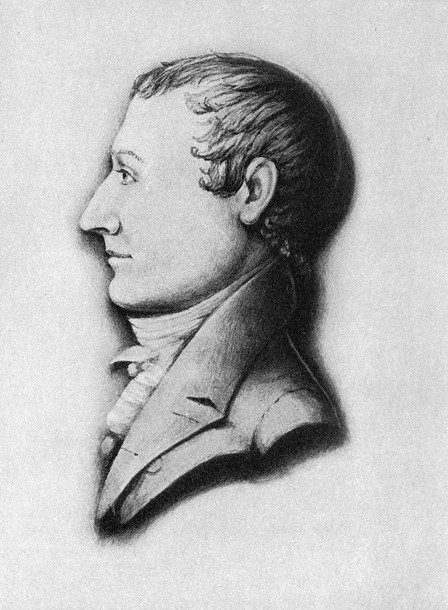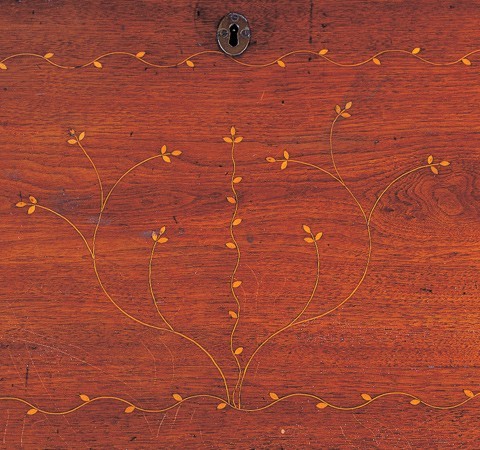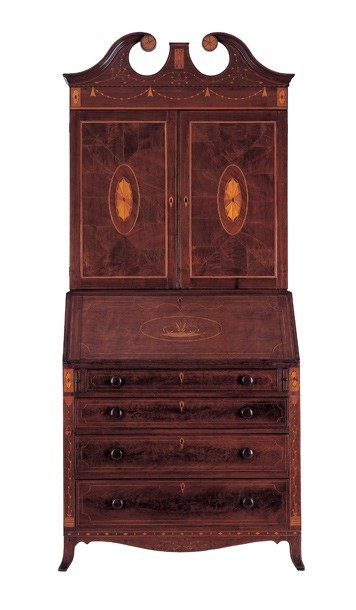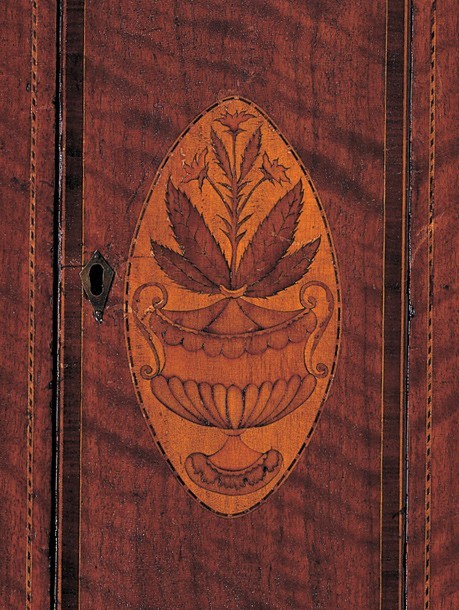
For the Ohio, tile overmantel formerly in a Woburn, Massachusetts, house, ca. 1888. Tin-glazed earthenware. 20 1/2" x 30 1/2". (Courtesy, Henry Ford Museum.)

Charles Sullivan, View of Fort Harmar from the Virginia Side, Marietta, Ohio, ca. 1835. Oil on canvas. 20" x 28". (Courtesy, Peter Tillou Works of Art.)

Map of the Ohio Company purchase, ca. 1787. Ink on paper. (Courtesy, Ohio Company Papers, Slack Research Collections, Dawes Memorial Library, Marietta College.)

Marietta in 1792, Marietta, Ohio, ca. 1848. Watercolor on paper. 7 1/2" x 10". (Courtesy, Hildreth Collection, Slack Research Collections, Dawes Memorial Library, Marietta College.)

Sawbuck table attributed to Truman Guthrie, Washington County, Ohio, 1790–1800. Tulip poplar and oak. H. 26 1/5", W. 35 1/2", D. 23 1/4". (Courtesy, Ohio Historical Society, Campus Martius Museum.)

Jonathan Sprague, corner cupboard, Marietta, Ohio, ca. 1788. Walnut. H. 70", W. 41 1/2", D. 18 1/2". (Courtesy, Ohio Historical Society, Campus Martius Museum.)

Detail of the upper shelves of the cupboard illustrated in fig. 6.

Clock case attributed to Isaac Washington with movement by D. B. Anderson, Marietta, Ohio, ca. 1823. Painted tin (case); brass (movement). H. 25 1/4", Diam. 9". (Courtesy, Ohio Historical Society.)

William Mason, desk, Lowell, Ohio, 1800–1810. Cherry with tulip poplar. H. 53 1/2", W. 42", D. 21 1/4". (Courtesy, Ohio Historical Society, Campus Martius Museum.)

E. Ruggles, Plan of the City of Marietta, 1788. Engraving on paper. 16 3/4" x 20". (Courtesy, Ohio Company Papers, Slack Research Collections, Dawes Memorial Library, Marietta College.)

Portrait of Joshua Shipman from Mary Walton Ferris, Dawes-Gates Ancestral Lines: A Memorial Volume (Milwaukee, Wis.: Privately printed, 1931), pl. 21.

Salt box, Marietta, Ohio, 1788–1800. Unidentified wood. H. 12 5/8", W. 6 1/2", D. 3 5/8". (Courtesy, Ohio Historical Society, Campus Martius Museum.)

Chest of drawers, Washington County, Ohio, 1810–1820. Cherry and various wood inlays with tulip poplar, pine, and oak. H. 44 3/4", W. 41 5/8", D. 23 3/4". (Courtesy, Ohio Historical Society, Campus Martius Museum.)

Outline map of Washington County, Ohio, 1881. Lithograph. (Courtesy, Dawes Memorial Library, Marietta College.) Williamstown is marked in red, Henderson Hall is marked in blue, and the arrow shows the location of Blennerhassett Island.

Contemporary image of Blennerhassett Mansion from Henry Howe, Historical Collections of Ohio (Norwalk, Ohio: Laning Printing, 1896). (Courtesy, Dawes Memorial Library, Marietta College.)

Portrait of John Richardson, Marietta, Ohio, 1800–1820. Oil on canvas. 31 7/8" x 27 1/2". (Courtesy, David O. Richard.) The inlaid frame is original.

Library bookcase attributed to Richard Rood, Washington County, Ohio, 1810–1820. Cherry and burled walnut with pine. Dimensions not recorded. (Courtesy, Henderson Hall.)

Tall case clock, Washington County, Ohio, 1810–1820. Cherry with tulip poplar. Dimensions not recorded. (Courtesy, Henderson Hall.) The dial bears the mark of Ohio clockmaker William Green, but the movement is English.

Sideboard, Washington County, Ohio, 1790–1810. Walnut and various wood inlays with tulip poplar and pine. H. 35 1/2", W. 67 3/4", D. 22 1/2". (Courtesy, Ohio Historical Society.)

Detail of an inlaid flower on the sideboard illustrated in fig. 19.

Desk, Washington County, Ohio, dated 1819. Walnut and various wood inlays with tulip poplar. H. 47 5/8", W. 41", D. 25 3/8". (Courtesy, Dayton Art Institute.)

Detail of the interior of the desk illustrated in fig. 21. The lion-head pulls appear to be original.

Detail of the inlay on the fallboard of the desk illustrated in fig. 21.

Detail of the inlay on the lower drawer and skirt of the desk illustrated in fig. 21.

Miniature chest of drawers, Ohio Valley, possibly Washington County, 1815–1830. Walnut and various wood inlays. Dimensions and secondary woods not recorded. (Private collection.)

William Patton, desk-and-bookcase, East Tennessee, or possibly Virginia, 1805–1815. Cherry, walnut, and light wood inlay with tulip poplar. H. 86", W. 41", D. 22 3/4". (Courtesy, Tennessee State Museum Collection: Photo, Bill LaFevor.)

Tall case clock, probably Pulaski County, Virginia, ca. 1810. Mahogany, cherry, walnut, holly, maple, bone, and horn with tulip poplar. H. 108", W. 24", D. 15". (Courtesy, Colonial Williamsburg Foundation.)

Chest of drawers, Chester County, Pennsylvania, 1715–1750. Walnut and light wood inlays with pine. H. 49 1/8", W. 41 1/2", D. 22 3/8". (Courtesy, Winterthur Museum.)

Detail of the map illustrated in fig. 10 showing the Point. Joseph Buell’s tavern is highlighted in red and his home in blue.

Desk-and-bookcase, Washington County, Ohio, 1800–1812. Walnut and various wood inlays with pine. H. 88 3/8", W. 39 3/8", D. 20 5/8". (Courtesy, Ohio Historical Society, Campus Martius Museum.)

Tall clock case, Washington County, Ohio, 1800–1812. Mahogany and various wood inlays with tulip poplar and white pine. H. 100 1/4", W. 17 1/2", D. 11". (Courtesy, Ohio Historical Society, Campus Martius Museum)

Detail of the inlay on the fallboard of the desk-and-bookcase illustrated in fig. 30.

Detail of the inlay on the hood of the tall clock case illustrated in fig. 31.

Detail of a corner leaf inlay on the base plinth of the tall clock case illustrated in fig. 31.

Tall case clock with movement by John Reynolds, Hagerstown, Maryland, 1800–1820. Mahogany with yellow pine and tulip poplar. H. 107 7/8", W. 20 3/4", D. 10 3/4". (Private collection; photo, Museum of Early Southern Decorative Arts.)

Detail of the urn-and-flower inlay on the plinth of the tall clock case illustrated in fig. 31.

Tall case clock with movement by Joseph Graff, Hagerstown, Maryland, 1800–1820. Cherry with tulip poplar. H. 92", W. 19 1/4", D. 11 5/8". (Private collection; photo, Museum of Early Southern Decorative Arts.)

Detail of the inverse vine-and-leaf inlay on the base plinth of the tall clock case illustrated in fig. 31.

Detail of the map illustrated in fig. 10 showing the population centers. The Point is in blue and Campus Martius is in red.
